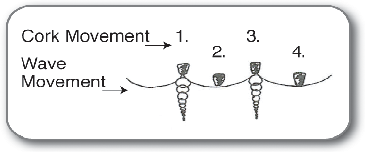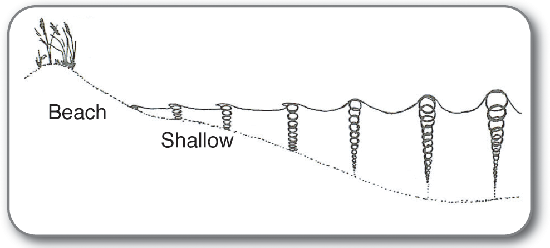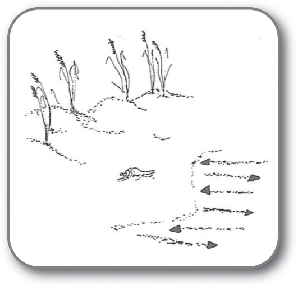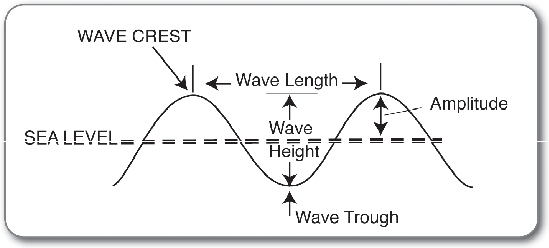Waves Fact Sheet
By Margaret Olsen, Southeast COSEE Education Specialist
You can download the fact sheet as a Microsoft Word document, an Open document, or an Adobe PDF
Anything that causes water to move can produce a wave: earthquakes, underwater landslides, changes in atmospheric pressure, underwater volcanic eruptions, the movement of ships, or even fish jumping. The most common cause of surface waves in the ocean is the wind blowing across the water. Once set in motion by the wind, as long as the wave is in deep water, the energy of the waves is passed from water particle to water particle without the water actually moving. The size of a wave depends on how long the wind blows, the strength of the wind, and the distance the wind blows (known as the fetch). Remember “how long, how strong, how far.”

The energy of the wave moves forward and also moves the water up and down as well. The water in a wave moves in a circular orbital pattern downward to a depth of one-half the wavelength.
As long as the water is deep enough for it to complete its downward orbital motion, only the energy of the wave is passed forward, not the water.
When waves near shore, they change because the water molecules can no longer complete their downward orbital motion. As the depth of the water decreases, the bottom of the wave begins to feel drag and the energy movement in the wave slows down, shortening its wavelength. This flattens the circular wave motion into an oval shape. The back of the wave is now traveling faster than the front and overtakes it, forcing the wave into a peak. The wave breaks or spills over when the depth is less than one-half its wavelength.


When a wave breaks, it does move the water. The water rushing onto a beach is called a wash or swash and the water returning to the ocean is called a backwash or undertow. As the water rushes onto the shore, it carries sand forward and carries sand backward as it rushes back out to sea. Therefore, some waves transport sediment on to the beaches. The wash brings sand up onto the beach but the gentle backwash is not able to carry as much sediment back to the ocean. These waves result in deposition or building of the beaches.
All waves have the same measurable characteristics. The highest part of a wave is the crest; the lowest part is the trough. The vertical distance between the wave crest and trough is the wave height. The amplitude of the wave is half of the wave height. The distance from a certain point on one crest or trough to the same point on the next crest or trough is the wavelength. The period is the amount of time it takes for succeeding crests to pass a specified point.

Because of the shape of the South Atlantic Bight, the average, historic significant wave heights vary due to the width of the continental shelf. The average historic significant wave heights (see wave glossary for definition) measures off Cape Hatteras, NC are 3 m (9 ft); off Charleston, SC–1.5 m (4.5 ft); off Savannah, GA–1 m (3 ft); and off Cape Canaveral, FL– 2 m (6 ft). Georgia's coast is located further west than any of the other Southeastern states and there for has only moderate wave energy, the lowest along the southeast Atlantic coast.